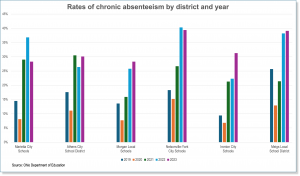News
Chronic absentee rates double in most school districts post-pandemic
By: Shane Scalfaro
Posted on:
ATHENS, Ohio (WOUB) — Chronic absenteeism in most Ohio school districts has doubled since before the pandemic, with school officials struggling to find ways to get students back into schools.
Marietta City Schools Superintendent Brad Silvus said COVID hurt schools more than many people realize.
“Once the pandemic happened, being absent from school was much more acceptable,” said Silvus.
The Ohio Department of Education defines chronic absenteeism as “a student missing 10% or more of the school year for any reason.”
This includes excused and unexcused absences, as well as suspensions.

Athens High School Principal April Stewart said one reason for this is that expectations have changed.
“Everybody got up, everybody got dressed, everybody went to school,” said Stewart. “Now it’s a little bit easier to be like, well, I might be able to stay home a few days and not go back to school, and then I’ll just catch up.”
In the Athens district, the rate of chronic absenteeism in 2021 was nearly double the 2019 rate. The number dipped slightly in 2022 then bounced back up in 2023.
In response to the rising numbers, Stewart said the Athens City School District is talking to families more.
“How can we help you? What can we provide for you? And if we don’t have the ability to provide it, how can we find you someone who can do that?” said Stewart.
Athens Truancy Officer Monna French has put a new system in place for the coming school year.
“Anybody that missed a certain number of days last year, I’m going to ask two members of the staff of that building to make intentional contact with that student every day for several days,” said French.
Brad Silvus said Marietta, where chronic absenteeism remains nearly double its prepandemic level, is doing something similar.
“We’ve hired more people to help reach out and help go out and talk to families,” he said. “And we’re doing more to try and reach out ahead of time.”
Marietta City Schools has also invested in more mental health resources.
“We’ve also brought more mental health opportunities into our schools for kids,” said Silvus. “We have counselors in every building so that if there are some issues going on, they can actually go and see the counselor there at school.”

